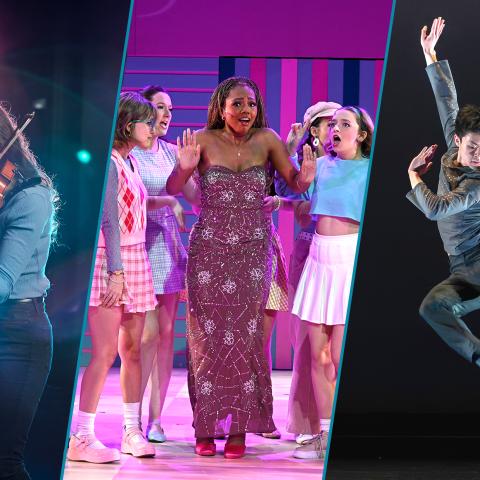Explore the World of Throat Singing, Overtone Singing, and Other Multiphonic Vocal Techniques
Composer, singer, and sound artist Ken Ueno '94
Image courtesy of EMPAC/Mick Bello
The Have You Heard? playlist series offers brief introductions to musical genres, concepts, tools, artists, and more that may be less familiar to wider audiences. In this edition, Ken Ueno '94 curates a selection of pieces that showcase different forms of multiphonic singing.
Recording technology has made it commonplace for singers to pitch shift, auto-tune, and loop their own voices, and it can be easy to forget just how much the human voice, unadorned, is capable of. For one, there is vocal overdubbing, which allows for artists to record multiple tracks of their own voice, stacking layers of notes into complex compositions. Contemporary artists have used overdubs to stunning effect, from the chart-topping work of Bobby McFerrin to more experimental explorations such as Björk's album Medúlla. But even these techniques require technology to pull off.
Watch Ken Ueno discuss and demonstrate his vocal extended techniques.
Many of the aforementioned technological effects can actually be achieved by a single human voice through multiphonic singing, where a singer can simultaneously combine notes, tones, and even rhythmic textures. "The human vocal mechanism is capable of many more sounds than are necessary for language," says composer, singer, and sound artist Ken Ueno '94, a professor at UC Berkeley who studied composition at Berklee. "I have been inspired by diverse vocal traditions and individual artists who blew me away. These artists stretched my imagination of what is possible to sing."
Multiphonic practices have shown up in many cultures from around the world and go back centuries, including Tuvan throat singing, which involves guttural expressions of the voice, and overtone singing, in which a singer manipulates the vocal tract in order to create more than one pitch in the same breath. Modern examples of throat singing can be heard in the Dune soundtrack as well in the video game Star Wars Jedi: Fallen Order. In 2014, noted multiphonic singer Lalah Hathaway '90 '22H earned a Grammy Award for her overtone vocal performance in the song "Something" by Snarky Puppy.
In the following playlist, Ueno offers several of his favorite works of multiphonic vocal music, from throat singing to heavy metal screaming to, in the case of one of his own pieces, the lack of breath.
Tracks and Notes
All commentary by playlist curator Ken Ueno
1. 'Deep Blue,' Sainkho Namtchylak
Ueno: "[Charles] Bukowski says he’d forgotten which track of classical music initiated his lifelong engagement with it in his poem, 'Classical Music and Me.' Similarly, I’ve forgotten which piece introduced me to throat singing in my early 20s, which set me on my path as a vocalist. Later, I was introduced to Sainkho’s singing. Hailing from Tuva, where women are discouraged from throat singing, she discovered/invented her own way to sing. This track features her superhuman low range. She’s one of my heroes."2. 'Uja,' Tanya Tagaq
Ueno: "The Inuit have a throat-singing tradition too. And, like the Tuvans, the tradition is mostly gendered—it is the women who throat sing. Tanya Tagaq is a radical Inuk artist who brings forth traditional throat singing of her culture into new expressive, contemporary spaces."3. 'UMNGQOKOLO,' by the Xhosa
Ueno: "The Xhosa people of modern-day South Africa also have a throat singing tradition."4. Tenores Santu Franziscu of Sardinia
Ueno: "Completing our tour of throat singing traditions from around the world, here is an example from Sardinia."5. 'Voice Piece: One-Note Internal Resonance Investigation,' Joan La Barbara
Ueno: "Joan La Barbara learned to circular sing and sing multiphonics in a unique way. Collaborating with important composers, as well as composing her own pieces featuring her extended techniques, she is a pioneer in expanding the vocabulary of vocal sounds in contemporary classical music."6. 'States,' Shelley Hirsch
Ueno: "Shelley Hirsch is a national treasure. A truly American shaman, she frenetically channels different types of vocal styles (jazz, Broadway, and the avant-garde) and juxtaposes them in wild narratives that presage the storytelling energies of the internet age."7. 'Litany IV,' Moonchild (Mike Patton)
Ueno: "Even rock stars can be experimental. Mike Patton [of hard rock band Faith No More] bridges the screamo vocalizations of metal with other sounds and the structural invention of experimental music in this piece by John Zorn."8. 'Strange Fruit,' Billie Holiday
Ueno: "There are many versions, but this three-minute version [from 1959] is a tour de force. A mini opera, some lines are delivered staccato and dry, like a recitative. Billie Holiday slides into blues notes and breathes vibrato into the second half of words like 'strange' (a micro text-setting distortion), saving the largest fully-voiced interval for the last note. Here is everything I want to continue to unpack and learn for the rest of my life as a composer, vocalist, and social activist."9. 'Tard,' Ken Ueno (featuring Du Yun, Matt Evans, and Amy Garapic)
Ueno: "Finally, a piece of mine. I’ve been thinking of this piece from 2018, after George Floyd and more recently, during the uptick in violence against Asian Americans. I hold my breath in a bowl of water for two minutes as an analog to the suspension of my breath and the muting of my voice as a person of color. Risking my life to protest the underlying premise of being of Asian American, invisibility, I am asking, 'What do I need to do for you to hear/see me?'"



